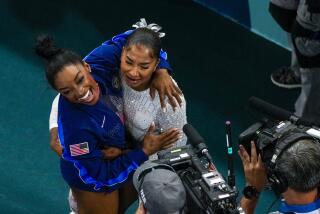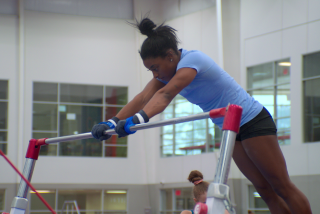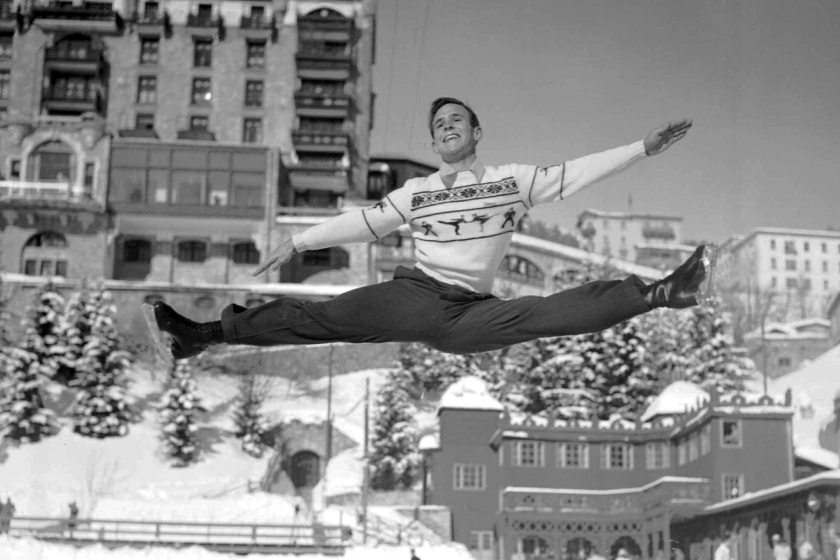Muscles Are a Must : Body Builder Lets Swimming Career Float Away
- Share via
It’s ironic that Carla Dunlap--one of the best-known female body builders in the world--did everything possible to hide her muscles nine years ago.
As a teen-aged speed swimmer for the YWCA in her hometown in New Jersey, Dunlap had a lot of muscle, which was good for strength.
But when she switched to synchronized swimming, Dunlap really stuck out. Her build was unusual in the sport.
“I was so muscular that I didn’t float well,” said Dunlap, who is now a guest trainer for the body-building and fitness camp at Loyola Marymount University.
However, her athletic ability allowed her to succeed and in 1978 she was part of the Texas YWCA team that received a bronze medal in the Olympic Sports Festival.
“I had to quit because I had a job and the swimming was requiring so much time that it was like having two full-time jobs,” said Dunlap, who majored in ad design at the Newark School of Fine and Industrial Arts.
During her swimming days, the thought of anyone working for bulk was a concept Dunlap couldn’t understand.
“When I first saw pictures of muscular women,” Dunlap said, “I couldn’t believe they were actually training to get muscles when all the time I had been covering them up.”
Apparently Dunlap was in the wrong sport. The muscles weren’t going to leave her body, so she made a change. Only this time muscles were a must.
A sports photographer who had seen Dunlap swim showed her photos of body builders and suggested she compete.
A few months later, Dunlap entered her first body-building competition--the Best in the World--in 1980. She competed without weight training and placed fifth.
“I didn’t even know how to train,” she said, laughing at the thought. “I just entered for the heck of it and to see what it was like.”
And almost a decade after quitting water sports, Dunlap has given up covering up. She would rather hang around in a tank top and shorts to show off her well-defined legs and split biceps.
At 33, Dunlap is considered the grand lady of body building by her peers, and she’s introduced at exhibitions as the “Black Madonna of Muscle.”
“She’s one of a few body builders who has respect from everybody,” said three-time and reigning Ms. Olympia Cory Everson. “Carla has respect from athletes as well as the public.”
That has a lot to do with her accomplishments and, many say, the way she represents the sport.
“Carla has helped formulate what body building is about,” Everson said. “She’s been a true feminist in the sport and she’s very helpful and friendly.
“Not many people in this business are willing to give and give and give like Carla.”
Dunlap believes the admiration developed because she’s stuck to the principles of being an athlete and hasn’t gone out of her way just to make money. She’s not conceited, but she’s always honest and very blunt.
“I just don’t like to play games,” she said. “I respect others and as a result they respect me.
“I’ve learned that you get a lot further by having integrity.”
Integrity and respect aside, Dunlap is most admired by body builders for what she had to deal with early in her career. As one of the first prominent female body builders, she took abuse from the public and the industry that competitors today don’t face.
“The early body builders have really had to fight,” Dunlap said. “We’ve developed a certain poise under fire.”
Dunlap recalls that when she became a body builder in 1980 she was unaccepted by the public.
“I would walk down 34th Street in New York and people would yell, ‘Oh my God, that’s a man,’ or they’d say, ‘Are you a dyke?’
“There’s just something about female body building that brings out very defined comments from the public.”
In the early ‘80s the abuse came from within the sport as well, Dunlap said, specifically from the men.
“At a competition in Connecticut, I couldn’t believe my ears when I heard one of the judges say (in reference to one of the competitors), ‘I’m not going to vote for her because I wouldn’t go to bed with her.’
“We were just very mired socially.”
Regardless, Dunlap kept training and in seven years of competitive body building has earned several high amateur titles and the Ms. Olympia--the ultimate professional competition for women in 1983.
That was a good year for Dunlap. She won the Grand Slam by sweeping the World Women’s Championships and the Caesars World Cup in addition to the Ms. Olympia.
A year earlier Dunlap competed for Ms. Olympia for the first time after winning two consecutive Ms. America titles. She placed second by one point to Rachel McLish, who had won the title in 1980.
“I saw the videotape afterward and realized that I should have won, which is a very rare thing for me to say. As far as muscularity goes, I should have beat her.”
Since winning the Ms. Olympia title, Dunlap has consistently placed in the top 10 in that event. In ’84 and ’85 she placed fourth and last year ninth.
This may be Dunlap’s last year in the Ms. Olympia contest, which is held in November at Madison Square Garden. As much as she’d like another title, she’s set some realistic goals.
“The competition is going to be real rough. I just tell myself, ‘This is what I can do,’ and that doesn’t necessarily mean winning.”
Dunlap competes at 135 pounds and says she doesn’t know her measurements because they’re not important.
“I just know that I can get into Size 7 pants, and I know that my body doesn’t undergo such drastic changes that I need an extended wardrobe--a pre-Olympia and a post-Olympia.”
Dunlap has gained her muscle mass slowly as opposed to some, who she says will bulk up in six months with the aid of drugs. She’s gained 20 pounds of solid muscle in seven years.
“The body-building mentality has a lot to do with the drug attitude,” she said. “If you don’t get huge fast, people tend to discount you.”
Even though there’s drug testing at the Ms. Olympia, Dunlap doesn’t think it’s quite up to par. It bothers her that she’s clean of growth aids, yet knows some competitors aren’t.
“It’s unofficial,” she said of the drug test conducted before the Olympia. “They just come back and say everybody passed. “I want to see it on paper.
“Besides, there are some growth hormones that can’t be tested for.”
She said she’d rather be natural even though it seems she could use some fast tissue repair supplied by certain drugs for a back injury.
Dunlap recently tore a muscle in the left side of her back, so she’s had to lay off leg work such as front squats that may cause too much pressure to the injury.
But the injury isn’t going to keep her out of the Olympia contest.
After a week of helping amateurs with training techniques, workouts, posing and nutrition at Loyola, Dunlap will begin to train.
Her day begins at 5 a.m. with yoga, preceding a light breakfast and two-hour weight workout.
She takes a break in the afternoon to watch soap operas and goes back to the gym for a workout in the evening.
More to Read
Go beyond the scoreboard
Get the latest on L.A.'s teams in the daily Sports Report newsletter.
You may occasionally receive promotional content from the Los Angeles Times.






